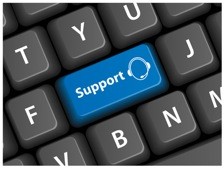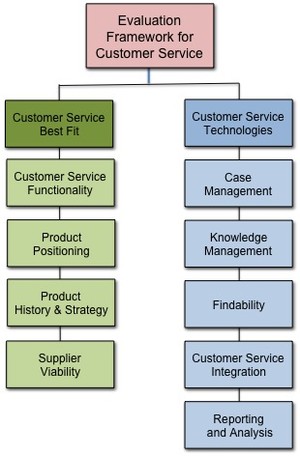Framework for Evaluating Customer Service Software
Delivering Answers and Solutions; Creating and Resolving Cases
This Framework for Evaluating Customer Service Software Products was updated in October, 2014. It’s adaptable to every type of customer service application. Customer Service Best Fit and Customer Service Technologies are the Framework’s two top-level evaluation criteria. Customer Service Best Fit tells you whether this product will work for your industry and your deployment environment, and whether it has the functionality you’re seeking. Customer Service Technologies examines the implementation of a product’s customer service applications.
NETTING IT OUT
We use this framework to evaluate customer service software products. You can use this framework yourself. This evaluation framework can be used to evaluate every type of customer service application: case management; knowledge management; virtual assistants; social monitoring, analysis, and interaction.
There are two high-level evaluation criteria: Customer Service Best Fit and Customer Service Technologies.
 Customer Service Best Fit evaluates the product’s capabilities, its market positioning, its history and strategy, the viability of its supplier, and what might drive you to select it.
Customer Service Best Fit evaluates the product’s capabilities, its market positioning, its history and strategy, the viability of its supplier, and what might drive you to select it.
Customer Service Technologies examines the implementation of a product’s customer service applications. This is a product-dependent criterion. Depending on the product, we’ll evaluate its implementation of case management, knowledge management, virtual assistant, community, and/or social customer service functionality. However, for all customer service products, we evaluate how well it integrates with other customer service products you may be using, as well as its search capability, and its reporting and analysis. These are essential capabilities for all customer service offerings.
CUSTOMER SERVICE
Customers Have Questions and Encounter Problems
In the course of doing business with you, customers have questions and encounter problems. Those questions and problems arise during activities that customers want to or need to perform in order to do their jobs or live their daily lives..
Why do they have questions? Because they don’t know, don’t understand, can’t figure out, or can’t find the information, the service, or the procedure that they need to accomplish their goals. Customers might ask:
- What’s the minimum age for a minor to fly unaccompanied?
- Can I rollover a 403b retirement plan to you?
- How do I get the upgrades to the product that I bought two years ago?
Why do they have problems? Because they can’t figure out how to install or use the products that they’ve bought, because they don’t understand or disagree with the bill that you sent them, or because the product that they purchased from you is defective or broken and they’d like it fixed or replaced. For example:
- Why did you automatically renew my service without asking me first?
- My monthly bill has an item that I did not purchase. I refuse to pay for it.
- The shirt that I bought from you last month has discolored. Can I return it for a new one? If so, then how?
Framework for Evaluating Customer Service Software Products
This illustration shows the Framework for Evaluating Customer Service Products and its top-level evaluation criteria.
Customer Service
Customer Service is all about answering customers’ questions and resolving customers’ problems. Ideally, you deliver those answers and solutions quickly, accurately, and consistently. So your customers can complete their activities and continue with their tasks.
Sometimes you cannot reach this ideal. The answer or the solution is not available because...(more)
(Download the PDF to read the entire article.)
Sign in to download the full article
0 comments
Be the first one to comment.




